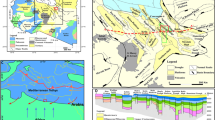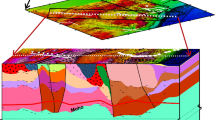Abstract
Triple mass-transport deposits (MTDs) with areas of 625, 494 and 902 km2, respectively, have been identified on the north slope of the Xisha Trough, northern South China Sea margin. Based on high-resolution seismic reflection data and multi-beam bathymetric data, the Quaternary MTDs are characterized by typical geometric shapes and internal structures. Results of slope analysis showed that they are developed in a steep slope ranging from 5° to 35°. The head wall scarps of the MTDs arrived to 50 km in length (from headwall to termination). Their inner structures include well developed basal shear surface, growth faults, stepping lateral scarps, erosion grooves, and frontal thrust deformation. From seismic images, the central deepwater channel system of the Xisha Trough has been filled by interbedded channel-levee deposits and thick MTDs. Therefore, we inferred that the MTDs in the deepwater channel system could be dominated by far-travelled slope failure deposits even though there are local collapses of the trough walls. And then, we drew the two-dimensional process model and threedimensional structure model diagram of the MTDs. Combined with the regional geological setting and previous studies, we discussed the trigger mechanisms of the triple MTDs.
Similar content being viewed by others
References
Beaubouef R T, Abreu V. 2003. Basin 4 of the Brazos-Trinity slope system, western Gulf of Mexico. Perkins Research Conference, 23: 45–66
Bexfield C E, McBride J H, Pugin A J M, et al. 2006. Integration of Pand SH-wave high-resolution seismic reflection and microgravity techniques to improve interpretation of shallow subsurface structure: New Madrid seismic zone. Tectonophysics, 420(1): 5–21
Bull S, Cartwright J, Huuse M. 2009. A review of kinematic indicators from mass-transport complexes using 3D seismic data. Marine and Petroleum Geology, 26(7): 1132–1151
Dong Dongdong, Zhang Gongcheng, Zhong Kai, et al. 2009. Tectonic evolution and dynamics of deepwater area of Pearl River Mouth Basin, Northern South China Sea. Journal of Earth Science, 20(1): 147–159
Dott R H. 1963. Dynamics of subaqueous gravity depositional processes. AAPG Bulletin, 47: 104–128
Ecker C, Dvorkin J, Nur A. 1997. Estimating the amount of gas hydrate and free gas from surface seismic. Stanford Exploration Project, Report 95, 10: 173–195
Felix M, Peakall J. 2006. Transformation of debris flows into turbidity currents: mechanisms inferred from laboratory experiments. Sedimentology, 53: 107–123
Garziglia S, Migeon S, Ducassou E, et al. 2008. Mass-transport deposits on the Rosetta province (NW Nile deep-sea turbidite system, Egyptian margin) — Characteristics, distribution, and potential causal processes. Marine Geology, 250(3–4): 180–198
Gee M J R, Uy H S, Warren J, et al. 2007. The Brunei slide: A giant submarine landslide on the North West Borneo Margin revealed by 3D seismic data. Marine Geology, 246: 9–23
Georgiopoulou A, Wynn R B, Masson D G, et al. 2009. Linked turbidite–debrite resulting from recent Sahara Slide headwall reactivation. Marine and Petroleum Geology, 26: 2021–2031
Gong Chenglin, Wang Yingmin, Zhu Weilin, et al. 2011. The Central Submarine Canyon in the Qiongdongnan Basin, northwestern South China Sea: Architecture, sequence stratigraphy, and depositional processes. Marine and Petroleum Geology, 28: 1690–1702
Grevemeyer I, Rosenberger A, Villinger H. 2000. Natural gas hydrates on the continental slope off Pakistan: constraints from seismic techniques. Geophys, 140(2): 295–310
Hampton M A. 1972. The role of subaqueous debris flows in generating turbidity currents. Journal of Sedimentary Research, 42: 775–793
Hampton M A, Locat L, Lee H J. 1996. Submarine landslides. Reviews of Geophysics, 34(1): 33–59
Harbitz C B, Løvholt F, Pedersen G, et al. 2006. Mechanisms of tsunami generation by submarine landslides: a short review. Norwegian Journal of Geology, 86: 255–264
He Yunlong, Xie Xinong, Li Junliang, et al. 2010. Depositional characteristics and controlling factors of continental slope system in the Qiongdongnan Basin. Geological Science and Technology Information (in Chinese), 29(2): 118–123
Hesthammer J H, Fossen. 1999. Evolution of geometries of gravitational collapse structures with examples from Statfjord field, northern North Sea. Marine and Petroleum Geology, 16(3): 259–281
Lamarche G C, Joanne C, Collot J Y. 2008. Successive, large masstransport deposits in the south Kermadec fore-arc basin, New Zealand: The Matakaoa submarine instability complex. Geochemistry Geophysics Geosystems, 9: 1–30
Leat P T, Tate A J, Tappin D R, et al. 2010. Growth and mass wasting of volcanic centers in the northern South Sandwich arc, South Atlantic, revealed by new multibeam mapping. Marine Geology, 275(1–4): 110–126
Lee C J, Nott J A, Keller F B. 2004. Seismic expression of the Cenozoic Mass Transport Complexes, Deepwater Tarfaya-Agadir Basin, offshore Morocco. Annual Offshore Technology Conference, 16741: 18
Liang Jin, Wang Hongbing, Guo Yiqun. 2006. Study of seismic velocity about gas hydrates in the northern slope of the South China Sea. Geoscience, 20(1): 123–130
Liu Lanfang, Wu Lushan. 2006. Topographic and morphologic characteristics and genesis analysis of Xisha Trough sea area in the South China Sea. Marine Geology & Quaternary Geology (in Chinese), 26(3): 7–15
Liu Feng, Wu Shiguo, Sun Yunbao. 2010. A quantitative analysis for submarine slope instability of the northern South China Sea due to gas hydrate dissociation. Chinese J Geophys, 53(4): 946–953
López C D, Spence G D, Kelley D S. 2010. Frontal ridge slope failure at the northern Cascadia margin: Margin-normal fault and gas hydrate control. Geology, 38: 967–970
Martinez J F, Cartwright J, Hall B. 2005. 3D seismic interpretation of slump complexes: examples from the continental margin of Israel. Basin Research, 17(1): 83–108
Maslin M, Mikkelsen N, Haq B. 1998. Sea-level-and gas-hydrate-controlled catastrophic sediment failures of the Amazon Fan. Geology, 26(12): 1107–1110
McCaffrey W, Kneller B. 2001. Process controls on the development of stratigraphic trap potential on the margins of confined turbidite systems and aids to reservoir evaluation. AAPG Bulletin 85(6): 971–988
McGilvery T A, Haddad G, Cook D L. 2004. Seafloor and shallow subsurface examples of Mass Transport Complexes, Offshore Brunei. Annual Offshore Technology Conference, 16780: 13
Morton R A. 1993. Attributes and origins of ancient submarine slides and filled embayments: example from the Gulf Coast basin. AAPG Bulletin, 77: 1064–1081
Moscardelli L, Wood L, Mann P. 2006. Mass-transport complexes and associated processes in the offshore area of Trinidad and Venezuela. AAPG Bulletin, 90(7): 1059–1088
Nardin T R, Hein F J, Gorsline D S, et al. 1979. A review of mass movement processes, sediment and acoustic characteristics and contrasts in slope and base-of-slope systems versus canyonfan- basin-floor basins. In: Doyle L J, Pilkey O H, eds. Geology of Continental Slopes. SEPM Special Publication, 27: 61–73
Nelson C H, Carlota E, Damuth J E, et al. 2009. Interplay of mass ransport and turbiditte system deposits in different active tectonic and passive continental margin settings: external and local controlling factors. Mass Transport Deposits in Deep Water Settings SEPM Special Publication, No. 95: 1–26
Newton C S, Shipp R C, Mosher D C, et al. 2004. Importance of mass transport complexes in the Quaternary development of the Nile Fan, Egypt. Annual Offshore Technology Conference, 16742: 10
Parsons J D, Garcia M H. 1998. Similarity of gravity current fronts. Physics of Fluids, 10(12): 3209–3213
Pirmez C, Marr J, Shipp C, Kopp F. 2004. Observations and numerical modeling of debries flows in the Na Kika Basin, Gulf of Mexico. Annual Offshore Technology Conference, 16749: 13
Postma G. 1986. Classification for sediment gravity-flow deposits based on flow conditions during sedimentation. Geology, 14: 291–294
Pu Yanping, Sun Chunyan, Chen Shicheng, et al. 2009. Geochemical prospecting of natural gas hydrate and resource evaluation in Qiongdongnan Basin-Xisha Trough of South China Sea. Geological Bulletin of China (in Chinese), 28(11): 1656–1661
Shipp R C, Nott J A, Newlin J A. 2004. Physical characteristics and impact of mass transport complexes on deepwater jetted conductors and suction anchor piles. Annual Offshore Technology Conference, 16751: 11
Su Xin, Chen Fang, Yu Xinhe, et al. 2005. A pilot study on Miocene through Holocene sediments from the continental slope of the South China Sea in correlation with possible distribution of gas hydrates. Geoscience (in Chinese), 19(1): 1–13
Sun Qiliang, Wu Shiguo, Thomas L, et al. 2011. Geophysical evidence for cyclic sediment deposition on the southern slope of Qiongdongnan Basin, South China Sea. Mar Geophys Res, 32: 415–428
Wang Xiujuan, Wu Shiguo, Xu Ning, et al. 2006. Estimation of gas hydrate saturation using constrained sparse spike inversion: case study from the Northern South China Sea. Terr Atoms Ocean Sci, 17(4): 799–813
Wang Shuhong, Yan Wen, Song Haibin. 2007. Change of gas hydrate reservoir and its effect on the environment in Xisha tough since the last glacial maximum. Journal of China University of Geosciences, 18(1): 39–48
Wu Shiguo, Sun Qiliang, Wu Tuoyu, et al. 2009. Polygonal fault and oil-gas accumulation in deep-water area of Qiongdongnan Basin. Acta Petrolei China (in Chinese), 30(1): 22–29
Xie Xinong, Muller R D, Ren Jianye, et al. 2008. Stratigraphic architecture and evolution of the continental slope system in offshore Hainan, northern South China Sea. Marine Geology, 247: 129–144
Yuan Shengqiang, Lv Fuliang, Wu Shiguo, et al. 2009. Seismic stratigraphy of the Qiongdongnan deep sea channel, Northwestern South China Sea. Chinese Journal of Oceanology and Limnology, 27(2): 250–259
Yuan Yusong, Yang Shuchun, Hu Shengbiao, et al. 2008. Tectonic subsidence of Qiongdongnan Basin and its main control factors. Chinese J Geophys (in Chinese), 51(2): 376–383
Author information
Authors and Affiliations
Corresponding author
Additional information
Foundation item: The National Natural Science Foundation of China under contract Nos 41306057 and 40906028; the Open Fund of the Key Laboratory of Submarine Geosciences, State Oceanic Administration under contract No. KLSG1406.
Rights and permissions
About this article
Cite this article
Qin, Z., Wu, S., Wang, D. et al. Mass transport deposits and processes in the north slope of the Xisha Trough, northern South China Sea. Acta Oceanol. Sin. 34, 117–125 (2015). https://doi.org/10.1007/s13131-015-0608-9
Received:
Accepted:
Published:
Issue Date:
DOI: https://doi.org/10.1007/s13131-015-0608-9




